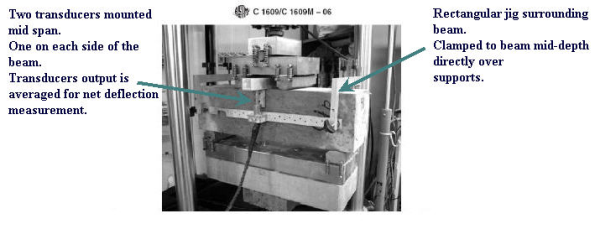Fiber reinforced concrete (FRC) is finding increased use in construction. FRC offers several advantages over rebar or wire mesh reinforced concrete including increased crack resistance, ductility, energy absorption, impact resistance and residual strength. FRC can also significantly lower materials and labor costs compared to rebar or wire mesh reinforced concrete.
ASTM C1609, Standard Test Method for Flexural Performance of Fiber-Reinforced Concrete (Using Beam With Third-Point Loading), is one specification governing the testing of Fiber Reinforced Concrete Beams.
C1609 requires the use of a closed-loop, servo controlled compression testing machine. The test is run at specified net deflection rates as measured at the mid-span point of the beam.
The testing machine must be capable of controlling at very slow speeds. Electromechanical testing machines are best suited for this type of application.
Figure 1 shows a typical test setup to perform the C1609 test. It is a third-point loading fixture with two support points and two loading noses on the top of the beam. A rectangular jig surrounds the beam and is mounted on the beam’s neutral axis directly over the supports. Two displacement transducers, one on each side of the beam, are mounted mid-span to measure beam deflection. The output of each transducer is averaged together to provide the net deflection measurement. This configuration ensures accurate measurement of mid-span deflection and minimizes errors due to concrete specimen twisting or seating in the supports.

Figure 1. Typical ASTM C1609 Test Fixture.
The test is run at a specified net deflection rate to a net deflection of L/600 (where L is the support span distance). After which it can be run at a higher specified net deflection rate until the specified endpoint.
Table 1. ASTM C1609 Net Deflection Testing Rates.

ASTM C1609 data analyses include 1st Peak Strength, Ultimate Strength, Residual Strength at L/600, Residual Strength at L/150 and Toughness, which is the area under load versus net deflection curve from 0 to L/150.

Figure 2 – Stress versus net deflection curve with ASTM C1609 analysis results.
Click here for more information on ADMET’s concrete testing systems.







